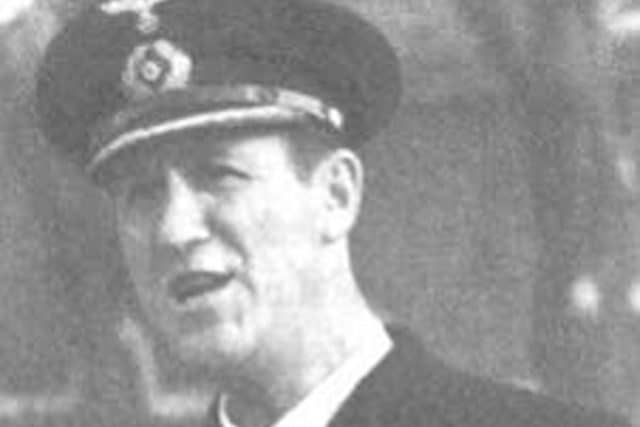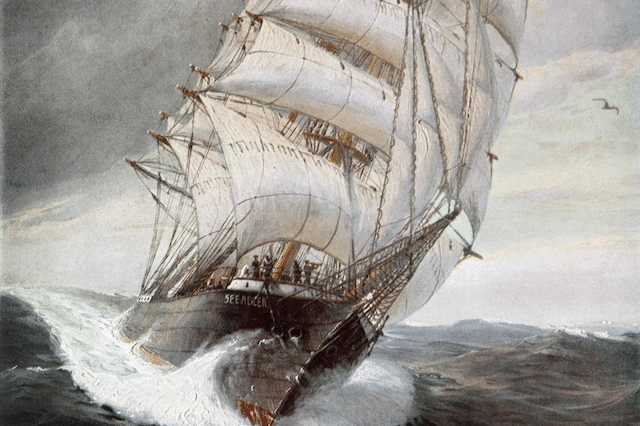Das boot! Schiff verlassen! While lesser known to many than the British pirates of popular imagination, a suite of German pirates defined by ingenuity, cunning and sometimes brutal approaches to handling perceived cowardice have left their mark on the annals of the high seas. We discover the likes of Hennig Wichmann, known for throwing prisoners overboard; the aristocratic pirate Barnim VI, Duke of Pomerania whose sophisticated operation included the construction of a port; WWII Merchant Raiders; and Gödeke Michels, the perversely merciful medieval pirate who punished those who did not resist him for their cowardice with death.
10. Klaus Störtebeker

Known as the “Germany’s most famous Pirate,” Kapitän Klaus Störtebeker was famous for downing beer and downing ships most quickly. In fact, the pirate’s name “Störtebeker” actually stands in reference to his apparent ability to swallow a four liter mug of beer in one quick gulp. Born in Wismar in 1360, Kapitän Störtebeker was originally a legitimate privateer, engaging in daring exploits as commander of a privateer group known as the Victual brothers, or “Vitalienbrüder.” Following the removal of the Victual Brothers from the Island of Gotland in the Baltic Sea where their base was located in the port town of Visby, Störtebeker and several other prominent privateers went rogue, capturing and plundering Hanseatic ships of trade and defense plying the Baltic and North Sea willy-nilly.
Inflicting great damage to shipping and embedding himself as legend, the rogue captor of ships was himself captured after a standoff gone wrong with a Hamburgian Fleet under the command of Simon of Utrecht, a German privateer and Hamburg city council member. Sentenced to death in Hamburg, Kapitän Störtebeker was executed by sword in 1401 (as depicted above). According to legend, his headless corpse walked past some of the bodies of his men after making a deal that any of his men whom his corpse could pass while walking after decapitation would themselves be spared. His life and accomplishments are now immortalized through a statue placed in Hamburg, the city where he was executed. In modern times, a statue of Störtebeker stands in Hamburg, the city of his demise, to commemorate the pirate and his exploits as a key interest point in German culture and history.
9. Barnim VI, Duke of Pomerania

Pirates may be seen as brigands and ruffians, but the concept of an aristocratic German pirate might be new to many people. Among the interesting individuals amongst the different categories of German pirates to patrol and plunder the waters of Northern Europe, the Duke of Pomerania-Wolgast, Barnim VI was a scheming marauder of aristocratic origin who held his title from 1394-1405. Efficient and organized, his piratic exploits even saw him establish a port and also a fort in Ahrenshoop, from which he conducted sea raids. After being singled out for supporting and facilitating “Likedeeler” raids in the Baltic Sea against the Hanseatic league trade and defense vessels, providing the ruffians with refuge areas in the form of the Peene River for winter and the Bay of Griefswald as an operations base, the Duke signed a treaty with the Teutonic Knights under their pressure to cease his attacks.
Out of the spotlight but not content to give up the pirate business, the Duke subsequently went on to engage in numerous acts of piracy on his own time. Ultimately, the Duke’s game caught up with him when he was captured by the Hanseatic League in the port of Kopenhagen. After his release, Barnim VI helped the dukes of Mecklenburg-Werle in their sieges of the German City of Lübeck, where he was eventually injured. On a pilgrimage to Kenz to dodge the risk of Black Death, the Duke, ironically, contracted the Black Death during the journey and died. He was then buried in Kenz and a likeness of the pirate of noble heritage constructed from wood was erected.
8. Gottfried Michaelsen

One of the harshest members of the Likdeelers group of German pirates, Gottfried Michaelsen (alternatively known as Gödeke Michels) put a strange twist on mercy. Born in 1360, Gottfried Michaelsen plundered the North Sea and Baltic Sea at the end of the 14th century. Manning ships that were fast and agile, Michaelsen easily overcame target vessels running the cold Northern waters and relieved them of their valuable cargo. While aggressive and ruthless in his bid for pillage and plunder, Michaelsen sought to steal valuable goods and not to arbitrarily end crewmen’s lives.
Far from a pacifist, Gottfried Michaelsen rewarded strength and zest for war in his victims. While it is common for raiders to intensify punishment against those who dare to resist them, dealing with Michaelsen was a counterintuitive matter if you wanted to survive, as fighting him proffered the best chance of gaining mercy. The pirate respected a good fight and in fact respected those who showed bravery in resisting him. Crewmen who dared to fight Michaelsen and tried to take him out were often given a chance, but those who failed to resist him and showed no desire to at all were not spared, but instead seen as cowards and promptly thrown overboard to their deaths in the cold North Sea and Baltic Sea waters. In 1402, no mercy was shown to Michaelsen when he was executed in Hamburg.
7. Cord Widderich

The exploits of a devious and remarkably creative German land-based pirate may sound like the plot of a medieval themed B-movie, but the story is true and represents one of the most novel aspects of German history. To a great degree empowered and motivated by a desire for martial revenge, Cord Widderich was a peculiar German pirate of Dithmarschen loyalty who conducted diverse operations against Frisian interests after further war actions were prevented by the Dithmarschen victory over Holstein. Seeing an end to hostilities but not to his own views and feudal anger, Widderich was simply not content to stop fighting and plundering.
Widderich opted to carry on his exploits and, bizarrely, conducted covert piracy operations from a church tower, stealing from villages and deceiving passing ships into running aground. Once stranded, the deceived ships would be helpless and able to be effortlessly boarded and plundered. This ruse went on for some time, establishing Widderich as a peculiar and successful pirate and also effectively made him the male equivalent of the siren of myth and legend that supposedly lured sailors to calamity on the rocks. In 1447, Widderich was caught after staying at an inn during a pilgrimage, and executed without trial.
6. Klein Henszlein

Having an admittedly epic-sounding German name, if not a tongue twisting one, pirate Kapitän Klein Henszlein was an intimidating German pirate operating from 1560 to 1573 in the North Sea, intercepting shipping and raiding the vessels for all they were worth. Attracting much hostility as a result of the damage and fear as word his work spread, he was hunted down with some effort and caught by a fleet of ships that had sailed out of Hamburg, determined to stop the pirate in his wake. So hated that capture and execution was not enough, Kapitän Klein was marched through the streets of Hamburg along with his captured men as a public spectacle of disgrace.
Next, Klein and his men were all beheaded at an insane pace by an executioner who described decapitating 33 pirates, including Kapitän Klein, in only 45 minutes. Once the execution was complete, the heads of the pirates were placed atop stakes and displayed, presumably serving as a stark deterrent to engaging in piracy. While pirates have gained something of folk hero status in society, it was clear that in the time of Kapitän Klein that interfering with goods and services and their movement by ship was not only a nuisance but a threat, especially in a harsh Northern European climate where goods could be scarce and trade essential to bring goods to sometimes remote communities.
5. Magister Wigbold

Pirates are known for being extremely dangerous, but one notorious yet mysterious member of the “Likedeelers” group of pirates was known for seeking results through more reasonable and less violent means. Operating in the North and Baltic Seas, the rather eccentrically styled German pirate “Magister Wigbold” (which translates to “strife-bold”) was a shadowy pirate whose real name was actually uncertain, together with the nature of his junior years. A marine raider carrying out daring acts of piracy as one of the “Likedeeler” pirates, Magister Wigbold was uniquely known for seeking negotiated ends to sea standoffs. His focus on conflict management sought peaceful procurement of pirate’s booty over a violent battle.
Magister Wigbold’s approach stands in sharp contrast to other Likedeeler pirates who much preferred a confrontational and warlike approach to piracy, often resulting in many deaths to the victims unfortunate enough to fall prey to their attacks. Alternatively known as “Master of the Seven Arts,” Wigbold fell victim to a concerted military effort by Hanseatic League that had been commissioned to wipe out the Likedeelers. Magister Wigbold managed to escape, but following the death of their leader, Kapitän Klaus Störtebeker, Wigbold was executed in 1402 in Hamburg.
4. Theodor Detmers

Nazi Germany did not only unleash such weapons as jet fighters, flying bombs, and monster tanks. The WWII activities of the Third Reich also included the strategic use of pirates. One of the most colorful pirates of the war was Theodor Detmers, a member of the German Navy since 1921. It was his command of the German Merchant Raider Kormoran that saw his pirate skills shine and be put to the test. In this role, Detmers captured several enemy merchant ships and destroyed others through judicious use of subterfuge.
His technique was to attempt to blend in and then ambush targets to be raided, taking them down with all of the procedure and protocol of an accomplished wartime pirate captain. Famously, he had his vessel pose as a Dutch ship at one point, only to be captured himself as a prisoner of war. His cover was blown after being forced to engage in battle with a certain Australian vessel when he apparently did not know the right Dutch ciphers to use and was promptly exposed as being in fact a merchant raider. Once in captivity, Detmers planned to escape from his captors by tunneling and stealing a sailboat; however, his effort was unsuccessful.
3. Bernhard Rogge

One of a small number of flag rank level German officers not detained by Allied forces at World War II’s end, Kapitän Bernhard Rogge was born in Schleswig and ultimately became a leading merchant raider captain during World War II. Part Jewish, Kapitän Rogge escaped persecution by the Nazis through a German Blood Certificate and conducted raids on Allied shipping using an ingeniously disguised merchant raider known as the Atlantis that even masqueraded as a Japanese vessel. He was also recognized by the Japanese during WWII, being one of only 3 German officers awarded a Japanese ceremonial sword by Emperor Hirohito himself. Operating like a privateer, the sanctioned pirate Rogge stole, intercepted, impeded, and destroyed, but unlike a battleship captain who might blow an enemy ship to smithereens, he did not kill.
While going to great lengths to intercept shipping, he went to equal lengths to spare lives. Fuel, food and other supplies were loaded and siphoned from victim vessels, which were then sunk, but not without ensuring that the enemy sailors had been given the opportunity to abandon their vessel. Known widely for his honorable treatment of prisoners, Rogge was able to gain respect by conducting wartime piracy in what could be termed a gentlemanly manner. As a result, Rogge became one of the few senior rank German officers not to be arrested and tried by the Allies given the exceptionally humane way he had acted as a pirate. One of his victims, Captain J. Armstrong-White, even stated “His treatment of prisoners left respect, instead of hatred.”
2. Hennig Wichmann

A brutal sea raider, German Pirate Hennig Wichmann was known for having survivors thrown overboard amongst his exploits in North Sea shipping raids and Baltic Sea attacks in the late 1300s. Originally a privateer serving the Dukes of Mecklenberg as part of the Victual Brothers privateer group tasked with interrupting enemy shipping runs by the Danish, Wichmann and other remaining crew members formed the illegitimate organization of pirates known as the “Likedeelers,” a word meaning “equal sharers.”
Equally they may have shared, but their treatment of crew captured was less than reasonable in the majority of cases. Set on plundering the ships of the Hanseatic league in the North and Baltic seas long after an end to official hostilities, Wichmann was focused on the plunder of vulnerable ships, ignoring official policy, states of hostility or peace, and the well-being of those captured. Hated in his time for having gone rogue, little mercy remained for Wichmann once he was captured by the authorities at hand. Along with 73 members of his crew, he was executed in Hamburg in 1402, showing that those who live by the sword indeed may die by the sword.
1. Count Felix von Luckner

A slightly different form of pirate compared to the rest of the entries, Count Felix von Luckner was a gentleman and a warrior who engaged in remarkable acts of wartime piracy during World War I. The noble-born von Luckner was the great-grandson of a distinguished German Count named Nicolas Luckner, who had served under Napoleon in battle and gained the title of Marshal of France. Count von Luckner was set apart by constant fighting in his school days, ultimately running away from home at the age of just 13. After failed starts in travel and career-seeking, von Luckner returned to Germany. He gained significant sailing experience, partially through the favor of the Kaiser himself. With this advantage, von Luckner reached the rank of Kapitän Leutnant. In WWI, during the British blockade, von Luckner was selected to lead a daring breach through tricks and piracy.
Whereas most sea battles were resolved with warships, von Luckner and his crew infiltrated British shipping and scuttled ships, using tactics of remarkable trickery including luring a British vessel close to help with the aid of a fake onboard fire. Initially, von Luckner and his crew disguised their ship, the Seeadler (Sea Eagle) as a Norwegian lumber transport, aided by elaborate modifications and disguises. Once British blockaders were encountered, the ruse was revealed by means including cannon fire. Over a time period of 255 days, 15 British ships were captured by the crew who were known as the “Piraten des Kaisers,” meaning “The Kaiser’s Pirates.” In a showcase of wartime chivalry, it was forbidden to cause death through this buccaneering. Not wanting to kill any British sailors, Luckner and his crew did not sink the captured boats until all of the crew of targeted ships could be evacuated safely.
3 Comments
I am seeking information on German river pirates in the Stuttgart area. Name is Ploch.
Life of a pirate. Some of those stories of pirates here are far more than the movie series Pirates of Caribbean. Thought Black Beard there is a brutal one, but seem not close enough to the deeds done by those pirates mentioned here.